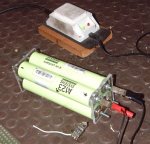OK - I am now on my 3rd. Though the last swap was 100% a knee jerk as I was travelling away from home and was not going to take chances.
R3's can be reluctant to start for a variety of reasons.
imo The battery size fitted is very borderline. Period. It is fine for 90% of cases - But those other 10% are the folk who have issues. Extremes.
imo - whilst bigger (and therefore lower resistance) cables are ALWAYS better - the stock cables are NOT restrictive. Unless you have wild compression. Cold improves electrical flow!.
We run dry sumps so should not really be dragging much "muddy" oil around. Unless it has stood for a bit. And the oil has all dropped into the sump.
ime Most LiFePO4 batteries made to fit "Harley size" holes are all a bit under powered. Most are about 6aH which gives the required CCA (on paper) but in the cold you HAVE TO let them warm up (put the lights on for 5-10s) - The issue then is that the surface voltage can drop a bit and if you're on the limit - you're stuffed. I have just seen a 7aH version - but for my next one I am going to have a 10aH made to measure by I-Tecc24 in Germany - and using maximum efficiency A123 cells. NOT ALL LiFePO4 cells are the same. A123 did make some 8aH cells - and I have a battery made from them on my Guzzi - That never fails to fire - you can weld with it.

I will not use this on the R3 as it is not BMS or Voltage controlled - It worries me that electronics might suffer - The Guzzi has NO electronics.
A123 cells have MONSTER discharge ratings - a good 2-3 times as high as most others.
Lead acid are OK but will suffer if you let them get very cold and then BURST them into life. Part of the acid will heat & boil fast - and the water evaporate near the plates. This leads to advanced sulphating AND they dry out. I FECKING HATE sealed batteries. Here in central Spain - 80% of batteries going soft is because they are simply DRY.
But there is an issue that most of us, I feel, are not taking into account. Throttle Body and ambient air temp. My bikes sleep inside. If I start cold with the bike inside still then it will usually fire straight up. If I wheel it outside and close the door behind me - and let it draw cold (say 0°C) air then spin as it might it takes a while to fire. Usually 2 or 3 button pushes. Ride and stop for fuel - no problems - ride leave it sat for 4 hours in the cold - expect reluctance again. My experience is that the more exposed the air at the inlet is the faster you'll see this.
I don't remember the numbers but I recall from ages ago that there is a table for optimum vaporisation airtemp, airflow etc. As soon as you get a spark on anything combustible - the R3 will run. Low compression. But if the fuel is not vaporising or even condenses on cold metal - then it ain't combustible.
In cold climates - I think I would stay with older technology & simply carry a small LiFePO4 booster pack inside my Jacket. A123 cells and a 2.5aH size.
I have a mate in the alps who uses some sort of cold start spray too. He swears by it.
Warm Climates - Lithium - just to stop the drying out effect. Which is a serious bloody issue for me.
OH - And I now carry one of these - EVERYWHERE -
NOCO - 1000A Lithium Jump Starter - GB40

